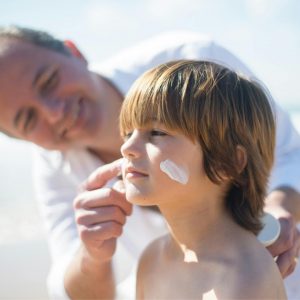Sun Safety Tips for Kids
Protecting children’s skin from the sun is crucial. Kids tend to spend a lot of time outdoors playing and exploring, which means their skin is regularly exposed to ultraviolet (UV) rays. Proper sun protection helps prevent sunburn, reduces the risk of skin cancer later in life, and helps avoid premature skin aging. As experienced dermatologists, we emphasize that sun protection should be a daily habit starting from infancy.
Choosing the Right Sunscreen for Kids
For children, we recommend using sunscreen with an SPF (sun protection factor) of 30 or higher. SPF 30 blocks about 97% of UVB rays, and increasing SPF beyond 50 offers only marginal additional protection. The key is applying sunscreen generously and reapplying it regularly.
Physical vs. Chemical Sunscreens
There are two main types of sunscreen ingredients: physical (mineral) blockers and chemical blockers. Physical blockers, such as zinc oxide and titanium dioxide, work by sitting on the skin’s surface and reflecting UV rays. They are often preferred for children because they tend to be less irritating and provide broad-spectrum protection.
Chemical blockers absorb UV rays and convert them into heat. These are available in many formulations, but sometimes can cause sensitivity, especially in children with sensitive or eczema-prone skin.
Physical blockers often appear as a thicker cream and may leave a slight white cast on the skin, which is normal. Chemical blockers tend to be thinner and easier to apply evenly.
Application Tips
Applying sunscreen properly is just as important as choosing the right one. Here are some tips:
- Apply sunscreen 15 to 30 minutes before sun exposure to allow it to bind to the skin.
- Use a generous amount — about one ounce (a shot glass full) for the whole body of a child.
- Don’t forget commonly missed areas like the ears, back of the neck, tops of the feet, and backs of the hands.
- Reapply every two hours or immediately after swimming or sweating.
- Spray sunscreens are convenient but can be applied unevenly. If using sprays, make sure to spray liberally and rub the sunscreen into the skin for even coverage.
Clothing and Physical Barriers
Sunscreen is just one part of sun protection. Wearing protective clothing is highly effective. Look for lightweight, breathable fabrics with a UPF (ultraviolet protection factor) rating, especially for swimwear and hats. Long sleeves, wide-brimmed hats, and sunglasses protect sensitive skin and eyes.
Limiting sun exposure during peak UV hours — generally between 10 a.m. and 4 p.m. — also reduces risk.
Special Considerations for Children’s Skin
Children’s skin is thinner and more sensitive than adults’, making them more vulnerable to sun damage. Physical blocker sunscreens are often better tolerated and safer for younger children and those with skin conditions like eczema. Avoid sunscreens with added fragrances or irritants when possible.
Protecting children’s skin from the sun is a vital step in preventing damage and future skin disease. Using an SPF 30 or higher sunscreen with physical blockers, applying it properly and consistently, wearing protective clothing, and limiting sun exposure during peak hours provides comprehensive protection. By establishing these habits early, you help your child build a lifetime of healthy skin.









